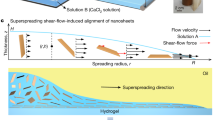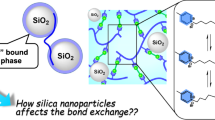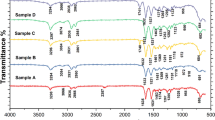Abstract
It is commonly accepted that the combination of the anisotropic shape and nanoscale dimensions of the mineral constituents of natural biological composites underlies their superior mechanical properties when compared to those of their rather weak mineral and organic constituents1. Here, we show that the self-assembly of nearly spherical iron oxide nanoparticles in supercrystals linked together by a thermally induced crosslinking reaction of oleic acid molecules leads to a nanocomposite with exceptional bending modulus of 114 GPa, hardness of up to 4 GPa and strength of up to 630 MPa. By using a nanomechanical model, we determined that these exceptional mechanical properties are dominated by the covalent backbone of the linked organic molecules. Because oleic acid has been broadly used as nanoparticle ligand, our crosslinking approach should be applicable to a large variety of nanoparticle systems.
This is a preview of subscription content, access via your institution
Access options
Subscribe to this journal
Receive 12 print issues and online access
$259.00 per year
only $21.58 per issue
Buy this article
- Purchase on Springer Link
- Instant access to full article PDF
Prices may be subject to local taxes which are calculated during checkout




Similar content being viewed by others
References
Gao, H., Ji, B., Jäger, I. L., Arzt, E. & Fratzl, P. Materials become insensitive to flaws at nanoscale. Lessons from nature. Proc. Natl Acad. Sci. USA 100, 5597–5600 (2003).
Meyers, M. A., Chen, P.-Y., Lin, Y.-M. A. & Seki, Y. Biological materials. Structure and mechanical properties. Prog. Mater. Sci. 53, 1–206 (2008).
Fratzl, P. & Weinkamer, R. Nature’s hierarchical materials. Prog. Mater. Sci. 52, 1263–1334 (2007).
Tang, Z., Kotov, N. A., Magonov, S. & Ozturk, B. Nanostructured artificial nacre. Nature Mater. 2, 413–418 (2003).
Podsiadlo, P. et al. Ultrastrong and stiff layered polymer nanocomposites. Science 318, 80–83 (2007).
Bonderer, L. J., Studart, A. R. & Gauckler, L. J. Bioinspired design and assembly of platelet reinforced polymer films. Science 319, 1069–1073 (2008).
Walther, A. et al. Large-area, lightweight and thick biomimetric composites with superior material properties via fast, economic and green pathways. Nano Lett. 10, 2742–2748 (2010).
Siglreitmeier, M. et al. Multifunctional layered magnetic composites. Beilstein J. Nanotech. 6, 134–148 (2015).
Podsiadlo, P. et al. The role of order, nanocrystal size, and capping ligands in the collective mechanical response of three-dimensional nanocrystal solids. J. Am. Chem. Soc. 132, 8953–8960 (2010).
Miszta, K. et al. Hierarchical self-assembly of suspended branched colloidal nanocrystals into superlattice structures. Nature Mater. 10, 872–876 (2011).
Liaqat, F. et al. High-performance TiO2 nanoparticle/DOPA-polymer composites. Macromol. Rapid Commun. 36, 1129–1137 (2015).
Bouville, F. et al. Strong, tough and stiff bioinspired ceramics from brittle constituents. Nature Mater. 13, 508–514 (2014).
Studart, A. R. Bioinspired ceramics. Turning brittleness into toughness. Nature Mater. 13, 433–435 (2014).
Munch, E. et al. Tough, bio-inspired hybrid materials. Science 322, 1516–1520 (2008).
Launey, M. E. et al. Designing highly toughened hybrid composites through nature-inspired hierarchical complexity. Acta Mater. 57, 2919–2932 (2009).
Weaver, J. C. et al. Analysis of an ultra hard magnetic biomineral in chiton radular teeth. Mater. Today 13, 42–52 (January–February, 2010).
Dumont, M., Tütken, T., Kostka, A., Duarte, M. J. & Borodin, S. Structural and functional characterization of enamel pigmentation in shrews. J. Struct. Biol. 186, 38–48 (2014).
Yu, W. W., Falkner, J. C., Yavuz, C. T. & Colvin, V. L. Synthesis of monodisperse iron oxide nanocrystals by thermal decomposition of iron carboxylate salts. Chem. Commun. 20, 2306–2307 (2004).
Yoo, D., Lee, J.-H., Shin, T.-H. & Cheon, J. Theranostic magnetic nanoparticles. Acc. Chem. Res. 44, 863–874 (2011).
Lee, N. & Heyon, T. Designed synthesis of uniformly sized iron oxide nanoparticles for efficient magnetic resonance imaging contrast agents. Chem. Soc. Rev. 41, 2575–2589 (2012).
Gamba, O. et al. Adsorption of formic acid on the Fe3O4(001) surface. J. Phys. Chem. C 119, 20459–20465 (2015).
Muhler, M., Schlögel, R. & Ertl, G. The nature of the iron oxide-based catalyst for dehydrogenation of ethylbenzene to styrene 2. Surface chemistry of the active phase. J. Catalys. 138, 413–444 (1992).
Zhang, L., He, R. & Gu, H.-C. Oleic acid coating on the monodisperse magnetite nanoparticles. Appl. Surf. Sci. 253, 2611–2617 (2006).
Bechtle, S. et al. Hierarchical flexural strength of enamel: transition from brittle to damage-tolerant behaviour. J. R. Soc. Interface 9, 1265–1274 (2012).
Yilmaz, E. D., Jelitto, H. & Schneider, G. A. Uniaxial compressive behavior of micro-pillars of dental enamel characterized in multiple directions. Acta Biomater. 16, 187–195 (2015).
Hugel, T., Rief, M., Seitz, M., Gaub, H. E. & Netz, R. R. Highly stretched single polymers: atomic-force-microscope experiments versus ab-initio theory. Phys. Rev. Lett. 94, 048301 (2005).
Reichmann, H. J. & Jacobsen, S. D. High pressure elasticity of natural magnetite crystal. Am. Mineral. 89, 1061–1066 (2004).
Stempflé, P., Pantalé, O., Rousseau, M., Lopez, E. & Bourrat, X. Mechanical properties of the elemental nanocomponents of nacre structure. Mater. Sci. Eng. C 30, 715–721 (2010).
Hu, K., Gupta, M. K., Kulkarni, D. D. & Tsukruk, V. V. Ultra-robust graphene oxide-silk fibroin nanocomposite membranes. Adv. Mater. 25, 2301–2307 (2013).
Kaushik, A. K., Waas, A. M. & Arruda, E. M. A constitutive model for finite deformation response of layered polyurethane–montmorillonite nanocomposites. Mech. Mater. 43, 186–193 (2011).
Ang, S. F. et al. Comparison of mechanical behaviors of enamel rod and interrod regions in enamel. J. Mater. Res. 27, 448–456 (2012).
Li, X., Chang, W.-C., Chao, Y.-J., Wang, R. & Chang, M. Nanoscale structural and mechanical characterization of a natural nanocomposite material: the shell of red abalone. Nano Lett. 4, 613–617 (2004).
Acknowledgements
The authors gratefully acknowledge financial support from the German Research Foundation (DFG) via SFB 986 ‘M3’, projects A1, A2, A6 and Z3. We would especially like to thank R. Schön (Hamburg University), D. Weinert (Hamburg University) and R. Schwaiger (Karlsruhe Institute of Technology) for the SEM-, HRTEM- and SHIM-measurements. S. Jördens is thanked for critically reading the manuscript.
Author information
Authors and Affiliations
Contributions
A.D. had the idea for the thermal treatment of nanosupercrystals, developed the material preparation and chose the analytical methods. A.F. synthesized the particles, analysed by A.K. using SEM, HRTEM and SAED, as well as by A.M. using SAXS, all of whom were supervised by H.W. T.K and A.K. analysed the material by TEM and SAED. H.N. and A.S. performed and analysed UHV-IRRAS and XPS. C.J. prepared the microcantilevers and micropillars by FIB. E.D.Y. performed and evaluated the micromechanical tests. V.A. contributed to this work in many discussions with G.A.S. and H.W. G.A.S. formulated the original task, had the idea for the microcantilever and micropillar experiments, formulated the analytical nanomechanical model, wrote the framework of the paper and supervised the investigations. All authors participated during all stages of the process.
Corresponding authors
Ethics declarations
Competing interests
The authors declare no competing financial interests.
Supplementary information
Supplementary Information
Supplementary Information (PDF 4770 kb)
Rights and permissions
About this article
Cite this article
Dreyer, A., Feld, A., Kornowski, A. et al. Organically linked iron oxide nanoparticle supercrystals with exceptional isotropic mechanical properties. Nature Mater 15, 522–528 (2016). https://doi.org/10.1038/nmat4553
Received:
Accepted:
Published:
Issue Date:
DOI: https://doi.org/10.1038/nmat4553
This article is cited by
-
Recastable assemblies of carbon dots into mechanically robust macroscopic materials
Nature Communications (2023)
-
Nanocrystal phononics
Nature Materials (2023)
-
Spatially resolved fluorescence of caesium lead halide perovskite supercrystals reveals quasi-atomic behavior of nanocrystals
Nature Communications (2022)
-
Adsorption of oleic acid on magnetite facets
Communications Chemistry (2022)
-
Nanoindentation of Supercrystalline Nanocomposites: Linear Relationship Between Elastic Modulus and Hardness
JOM (2022)



